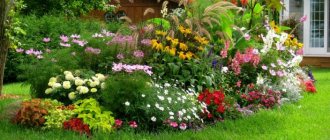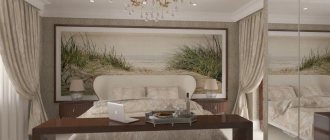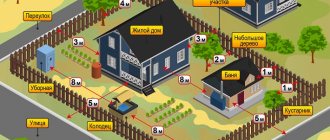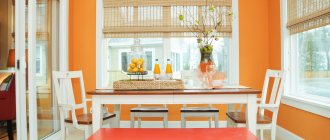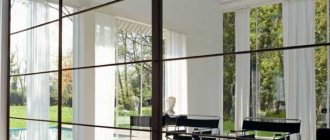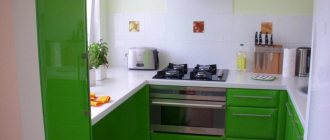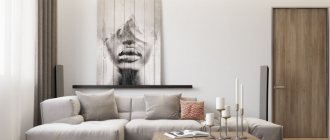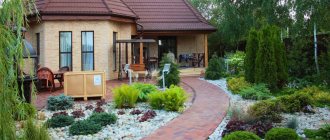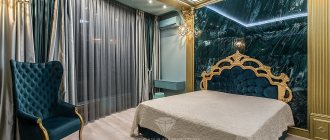Advantages and disadvantages of a narrow section
Many people believe that there are no advantages to an oblong plot of land. However, it is not. Here it makes sense to implement interesting ideas in its zoning. A rectangular plot of land can be easily divided into functional zones, and a suitable use can be found for each. Vineyard lovers will like this form of plot because the narrow space looks advantageous in the design of vines. Even if the territory is inconvenient, it is still possible to allocate a corner for a vegetable garden or garden , and this can be done without compromising the design of the elongated summer cottage.
The inconvenience in a territory of such geometry will be the impossibility of building a house with the layout you like; here you will have to proceed from the options available for such shapes. It will also be problematic to erect a high fence around the plot of land. A blind, high hedge will block sunlight, which is unfavorable for most plants used in landscaping. Trees that are too tall and provide a lot of shade are also not recommended for planting , as they visually conceal the space.
Did you know? Joseph Addison first mentioned the art of landscape design in 1712, but the term still arose much later, in 1828.
An almost impossible task in planning such areas is the problem of sound insulation, especially when there are noise sources in the immediate vicinity. It is advisable to involve specialist designers in planning an elongated garden plot. But if funds are limited, then you can try to arrange your own plot of land, using professional recommendations and special literature.
Design of a multi-level area
A plot of land with a slight slope and a couple of hills is not at all uncommon. It is recommended to build a house on such a site in the highest place. The space is leveled as much as possible, or left virtually unchanged. Landscaping begins with drawing up a project in which all the elements are linked together, since the more relief the terrain, the more noticeable minor errors are.
But there are undoubted advantages: if everything is done correctly, using competent geoplastics, each unevenness will become a kind of highlight of land ownership, and the cost of such “inconvenient” plots is much lower than ordinary ones. Difficulties arise with arranging a garden: it is important to know which plants love water, which are accustomed to drier soil - the latter are then planted in high places. Individual zones are separated by borders made of stone, logs, and boards, forming many tiers.
When the slopes are very steep, they are strengthened by planting trees and shrubs with powerful root systems. Each level is additionally “supported” by low fences made of stone, concrete, and brick. It is important to carefully consider the location of utilities, the location of heavy structures, paths, stairs, and drainage systems. It is advisable to design the area taking into account the movement of the sun - so that the garden is not shaded, private corners and recreation areas have a slight shade even at noon.
Planning Features
Long narrow plots are the most difficult to design. Since the area is quite limited and has an original shape, not all available house and garden design projects can be used. However, you should not despair, because there are a number of techniques for visually adjusting the territory. They make it possible to optically expand the space and make its appearance more proportional.
Such tricks include:
- use of diagonals;
- dividing space into different-sized sectors;
- formation of zones.
A site up to 20 m wide is considered narrow. A special feature of its design will be the use of the entire territory, including remote corners. Before planning begins, it is necessary to determine the main purposes of each land plot. For all buildings, you should think about the location in advance.
Learn how to design a rectangular area.
Houses on such areas are built in such a way that the residents living in them feel comfortable and comfortable. There may be a longitudinal or transverse arrangement. All communications should be designed in advance: water supply, sewerage, heating, electrical wiring, gas pipes. This must be done based on the location of the future house, as well as all other buildings on the site.
Location of the house
Since a residential building is the most important detail of any landscape, before designing and building it, you should consider the location of the home so that the side walls face west and east. Only in this case there will be no lack of sunlight in the room. The building shape is often preferred to be rectangular, but other options can be considered when designing.
This largely depends on the characteristics of the terrain. On a plot of this type, it is often possible to fit a building entirely along the wall, however, if you absolutely do not want to do this, you can consider the option of several floors or a house with an attic superstructure. If a rectangular house is chosen as the final one, then you can diversify its design with an original solution.
For example, it could be a building, the exit from the rooms of which can be made directly onto the territory of the garden plot. You can also think about a carriage-type structure, in which the rooms are located one after another and are walk-through .
In any case, the minimum width of the room should be 5–6 m, since if the room is narrower, it will be absolutely uncomfortable to be in it.
Zoning
If the plot is very small, its zoning may include only two parts - a building area and a compact front yard. On a typical elongated area, you can place the main zones, placing them one after the other. Experts recommend planning the following important functional areas:
- buffer;
- representative;
- private;
- technical.
When designing an elongated but large area, you may not adhere to the above principle. The house can be located in any part of the site and have any configuration.
Layout of a large elongated area Source aboutus.appspot.com
Buffer zone
This area is located right next to the gate. It is not mandatory, but it allows you to make home ownership more intimate and protected from strangers. It is in this part that it makes sense to place all the meters so that the inspection service employees do not go further into the site.
A thick hedge or any other type of fencing can be used to separate the buffer zone. If there is such a zone, a small part of the site is cut off, but the rest of the territory can be more freely designed.
Buffer zone fencing option Source houzz.co.uk
Representative zone
This is the part of the site that is the hallmark of the home ownership. It consists entirely of landscape design elements. The main element is usually the lawn. It can be supplemented with low ornamental plants, flower beds, garden sculptures, and an alpine slide.
Design option for a representative zone Source pinterest.es
A corner of the representative zone should be allocated for the arrangement of a garage or open parking. If the garage is planned as an extension to the house, then the entrance to it will lead through the front area of the site, taking up a lot of space, so it is better to allocate a place for the car closer to the entrance. As an element of the representative zone of the site, the garage should have an attractive appearance that matches the overall style of the landscape.
Parking space for a car Source pinterest.ru
To smooth out the linearity of a narrow and elongated area, the lawn should be made asymmetrical and irregular in shape, and decorative elements should not be placed symmetrically.
Lawn for a narrow area Source bg.decorexpro.com
See also: Catalog of companies that specialize in landscape design of sites.
Private zone
This is a relaxation area for the owners of the house and their guests. This part of the territory is used to build a gazebo, patio or just a canopy, under which furniture will be installed - a table with chairs, sun loungers, trestle beds, etc. Under the canopy or in the gazebo, you can arrange a summer kitchen. To make the layout of a narrow long area more comfortable, it is advisable to locate the private area as close as possible to the fence. In this case, it will turn out to be as intimate as possible, and at the same time it will not block the cottage.
Cozy sitting area Source pinterest.com
To make the seating area more comfortable, you can separate it with a pergola, hedge or picket fence. Dividing barriers should not be too high, and it is advisable that they allow light to pass through. The first rule does not apply to pergolas. If the slats in it are spaced widely, it looks quite transparent and light, which means it can be the same height as the canopy.
To save space, you can design the recreation area as a terrace attached to the house. It will serve as a porch. If it is equipped with sliding windows or removable glazing, it will be used as a closed veranda in winter.
Terrace near a house with pergolas Source customhomegroup.com
Technical area
This is the part of the site where outbuildings are located. Here you can also allocate space for drying clothes and, for example, for a greenhouse. The technical area may be located next to the house or behind it, depending on the location of the cottage.
Technical area with buildings next to the house Source pinterest.es
The technical area can be fenced off with a dense fence. If the area is not small, this will even help make it visually less elongated. But in small areas it is better not to install fences, but simply position the technical part so that it is not visible from the recreation area.
Choosing a style for an elongated area
To design an elongated plot of land, landscape designers recommend choosing one of the following styles.
- Classic or regular. A feature of this style is the choice of strict geometric shapes. They should be visible in everything: zoning, the shape of garden paths, the appearance of plants. Elements of pristine nature would not be appropriate here: boulders, untrimmed bushes and trees. Treated stones or wood can be used, but everything must be in the correct shape.
- Country. This direction involves stylizing the territory as a village. The style is not too expensive either financially, or in work during design, or in subsequent care. There are no clear and strict lines and shapes expected here, and there are no strict decor rules either. The main principle will be to create rustic comfort. Wood and stone are not processed and retain their natural structure. If there is supposed to be a reservoir, then it would be desirable for it to be overgrown with reeds.
- Japanese. Designed to reveal the beauty of the landscape. The following can be located on a site made in this style: a pond, a terrace, a Japanese gazebo, and large stones. An oriental style garden is characterized by a restrained color palette. It is undesirable to repeat the sizes and shapes of various decorative elements. Everything in this garden should contribute to peace.
- Architectural. It combines components from two design styles: classic and hi-tech. The main elements here are decorative elements in the garden, such as step-by-step paths, terraces, bridges, various arches, borders, and ponds. This garden is easy to maintain.
- Landscape or English. This style is the complete opposite of architectural. The main task here is to emphasize the naturalness and pristine beauty of nature. English gardens are not designed to subjugate the forces of nature, but, on the contrary, to blend harmoniously into the riot of greenery. Smooth lines and a natural look predominate, which promotes relaxation.
Ways to visually expand a site
In order to optically expand the space of an elongated section, the following tricks are used:
- You can plant trees of different sizes at different ends of the plot, with short ones placed at the beginning, tall ones at the end. Visually, the crowns of these trees will be on the same line, which will make the area not so narrow. In the same way, only large-scale plants located at the end of the garden are used.
- The next technique for visually making the area wider is to place bright objects in the background, such as a gazebo buried in colorful flowers or elements of garden decor in rich colors. This technique helps to visually bring the distant part of the site closer.
- You can optically expand the boundaries of the land plot with the help of garden paths located along a short fence. Paths can be diluted with planted plants.
- The most effective way would be to design the territory at different levels. At the same time, it is divided into segments with different heights. If the area already has relief, then using this method will be much less expensive. However, if the plot is flat, then you can still use this method, placing emphasis on different levels. The hill must be located in the central part of the territory, then it will distract more attention, and the elongation of the site will fade into the background. If you place a tall object in the background, this will visually bring that part of the garden closer.
Typical design errors may include:
- Planting tall trees along the fence, resulting in an alley effect.
- Construction of straight paths or beds along the fence.
- Not using the entire area. The far corners are not used and remain empty.
Did you know? Australia is considered the leader in world landscape design. More than 30,000 specialists in this field work here.
How to adjust space
This is the next question that comes up sharply after drawing up a zoning plan for a narrow area. There are a lot of visual correction techniques. Which of them is rational to use in our case?
First of all, try to use every inch of the space, including seemingly non-functional corners and the deepest corners. The main thing is not to repeat the chronic mistakes of narrow section design. For example, do not plant tall trees around the perimeter. Their height will only aggravate the situation and present the territory as even more elongated and disproportionate than it actually is.
Do not plant tall trees around the perimeter of the plot
The right effect will be achieved by planting this type of vegetation at the very end of the territory, along the short side. In the design of a long plot, bring low-growing subspecies of shrubs and fruit-bearing trees to the foreground. This is a great way to open up a space and give it a domesticated, lived-in feel.
Low-growing shrubs will make the area wider
You may not strive to maintain the visual integrity of the plot. A torn picture will also distract from the shortcomings of the land layout. In the design of an elongated site, follow a policy of clear zonal division of areas with an emphasis on highlighting the boundaries of functional parts. To do this, feel free to involve all kinds of architectural forms in the project, from symbolic fences to luxurious pergolas and arches. These elements will help shade the real boundaries of the object.
Emphasizing the boundaries of functional parts
Experts recommend trying to zoning a narrow area in another way. Divide it into several parts so that you can later fill them with sand, pebbles or sow them with grass. This approach is justified if the zones are not planned to be separated by solid fences and the entire territory remains visible.
In the design of a narrow area, you cannot use geometrically clear lines. This means that alleys and paths need to be made cleverly winding, meandering randomly among the trees. If you plan to lay the paths with tiles, then lay it in some kind of pattern, perhaps even ornamental.
Smooth lines will visually expand the boundaries of the site
Similar tactics must be followed when decorating flower beds in a narrow area. Flower beds are also given irregular shapes. In this case, the courtyard area seems wider, the garden – more voluminous.
An excellent counterbalance to the elongated shape of the allotment will be green spaces with spherical crowns.
A painful issue in the design of a long plot is the fence. If giving it up completely is unrealistic, then make it low, ideally multi-level and multi-colored. Low-growing weaving plantings can serve as additional decoration.
Decorate the fence with climbing plants
In the struggle to expand the site, it is permissible to use transverse lines. They can be depicted in borders, flower beds, or a strip of green hedge.
The transverse design will bring balance to the perception of the elongated territory.
Cross zoning brings balance
Bringing distant areas closer
If you did not get a virgin plot of land, but it was already inhabited by someone else, then perhaps for the successful design of a narrow plot you will also need to use techniques for visually zooming in/out of objects. For example, at the end of the garden there is a tall, beautiful tree, which is extremely frustrating to cut down. Use it for practical purposes. Plant another one diagonally from it, but only a smaller tree. This step will visually shorten the space. A good way to bring the remote part of the area closer is to include in the design of the elongated area a small gazebo, which, surrounded by flowers, will spread out in the backyard. If you don’t want to build a gazebo, put a fountain there or build a multi-tiered flower bed.
The gazebo will bring the remote part of the site closer
When designing a narrow area, you will need to focus on at least three objects. These could be: garden sculptures, decorative arches, secret gates. The background of the territory is designed brightly and colorfully, while near the entrance everything should look restrained. A cold palette is more appropriate here.
Bright flowers will visually expand the area
In the corrective design of the shape of a narrow area, green spaces are actively used. So, to visually expand the area, tree-like plants with large, bright yellow leaves or plants that bloom in yellow-orange are planted in the garden part.
Small architectural forms and decor
The main decorative elements of the elongated area are:
- Hedge. For a rectangular narrow area, a low hedge is suitable. The use of such an element helps to create visual fences and organize geometric shapes on the site.
- Flower borders. The outlines of flowerbeds of this type should be made smooth, then they will organically fit into the landscape of the area. The following plants are used for flower borders: cereals, tulips, irises, chrysanthemums, asters.
- Pergola. The placement of this element allows you to create coziness on the site, dividing it into separate corners. They are built from durable materials: wood, metal. The design can have a wide variety of shapes.
- Relief flower beds. Contribute to the visual expansion of a narrow area. They are easy to install and maintain. Plants used for planting on such “islands” are: low conifers, dwarf bushes, low perennial flowers.
- Mixborders. These are rectangular flower beds. They are usually installed at the boundaries of the site, along step-by-step paths. They are decorated with the following plants, planted in groups: low shrubs, vines, perennial flowers. The main condition is to compose mixborders in such a way that representatives of the flora continuously bloom or turn green throughout the season.
Also, in the design of an elongated garden area, the following decorative elements are used: lamps, sculptures, flowerpots, fences and railings, artificial ponds, fountains, lawns, garden furniture, paths and even gazebos and rotundas. The basic rules for their arrangement will be wisely chosen sizes, suitable materials and harmonious combination with other decorative elements. What plants can you choose when decorating?
Important! Inexperienced gardeners should not choose roses for planting, as they are capricious representatives of the plant world. Roses react negatively to untimely watering, improper feeding or lack of disease prevention.
To begin with, you need to take into account that some part of the territory will often be in the shade, therefore, plants that are not light-loving are planted there. It is best to give preference to easy-to-care for fruit and berry trees, bushes, cereals, and perennials . They must be arranged taking into account the general style of landscape design of the area. To emphasize the unique beauty of the site, you can plant: decorative sunflowers, bells, irises, tulips, asters, chrysanthemums, phlox.
Tips from area designers
The site needs to be organized wisely. After all, it is small in size, which means you need to take care not only to expand it visually, but also to use every corner.
You may be interested in: Layout of a 10-acre dacha plot for landscape design
For example, you can plant mushrooms in the most shady place. Plant a variety of trees, both fruit and ornamental. Make small beds, framing them with wattles for beauty. In a word, work with every small territory.

